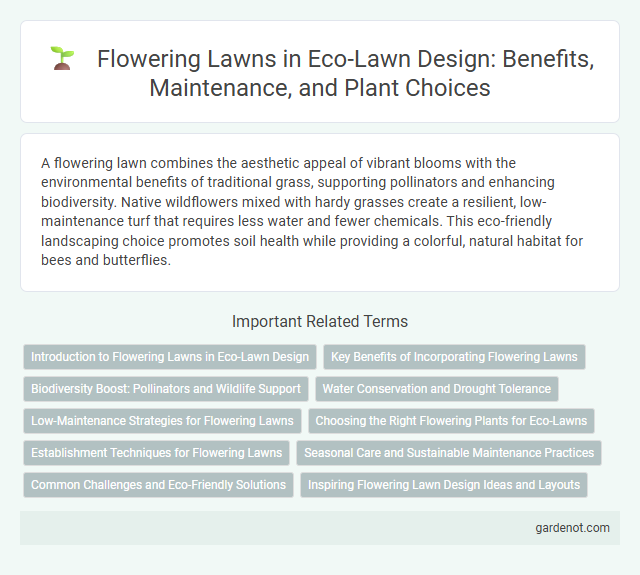A flowering lawn combines the aesthetic appeal of vibrant blooms with the environmental benefits of traditional grass, supporting pollinators and enhancing biodiversity. Native wildflowers mixed with hardy grasses create a resilient, low-maintenance turf that requires less water and fewer chemicals. This eco-friendly landscaping choice promotes soil health while providing a colorful, natural habitat for bees and butterflies.
Introduction to Flowering Lawns in Eco-Lawn Design
Flowering lawns incorporate diverse native wildflowers that enhance biodiversity and provide habitat for pollinators within eco-lawn designs. These lawns reduce the need for chemical inputs and frequent mowing, promoting sustainable landscape management. Integrating flowering species supports ecological balance and contributes to vibrant, resilient green spaces.
Key Benefits of Incorporating Flowering Lawns
Flowering lawns enhance biodiversity by providing habitats for pollinators such as bees and butterflies, promoting ecological balance. They reduce water consumption and chemical fertilizer use compared to traditional turfgrass, supporting sustainable landscaping practices. Incorporating flowering lawns also improves soil health through increased organic matter and native plant resilience.
Biodiversity Boost: Pollinators and Wildlife Support
Flowering lawns enhance biodiversity by providing essential habitats and nectar sources for pollinators such as bees, butterflies, and hummingbirds. These diverse plant species support a wide range of wildlife, contributing to ecosystem resilience and promoting natural pest control. Integrating flowering lawns into urban and suburban landscapes fosters ecological balance and encourages sustainable environmental practices.
Water Conservation and Drought Tolerance
A flowering lawn incorporates native, drought-tolerant plants that thrive with minimal irrigation, significantly reducing water consumption. These resilient species adapt to local climates, promoting sustainable landscaping through natural moisture retention and reduced mowing needs. By selecting permeable, deep-rooted flora, flowering lawns enhance soil health and conserve water resources in drought-prone areas.
Low-Maintenance Strategies for Flowering Lawns
Flowering lawns thrive with low-maintenance strategies such as selecting drought-tolerant native wildflowers and incorporating clover to reduce watering needs and improve soil nitrogen levels. Mowing less frequently at higher blade heights encourages deeper root growth and prolonged blooming periods, while mulching around plants conserves moisture and suppresses weeds. Using organic fertilizers and minimizing chemical inputs supports pollinators and maintains healthy soil ecosystems for sustainable flowering lawns.
Choosing the Right Flowering Plants for Eco-Lawns
Selecting the right flowering plants for eco-lawns enhances biodiversity and supports pollinators such as bees and butterflies. Native wildflowers like clover, self-heal, and creeping thyme thrive in eco-lawn environments, requiring minimal maintenance and water. Incorporating these species improves soil health while creating a vibrant, sustainable lawn alternative.
Establishment Techniques for Flowering Lawns
Establishment techniques for flowering lawns involve selecting native wildflowers and drought-resistant grasses to create a sustainable, low-maintenance turf. Proper soil preparation, including aeration and organic matter incorporation, ensures optimal seed germination and root development. Strategic seeding timing in early spring or fall enhances growth success, while minimal mowing preserves blooms and supports pollinator habitats.
Seasonal Care and Sustainable Maintenance Practices
Flowering lawns thrive with seasonal care tailored to the growth cycles of native wildflowers, including timely mowing in late spring and early fall to promote blooms and prevent weed dominance. Sustainable maintenance practices emphasize minimal chemical use, reliance on organic fertilizers, and hand weeding to preserve pollinator habitats and enhance biodiversity. Incorporating drought-resistant varieties reduces water consumption, supporting eco-friendly lawn management year-round.
Common Challenges and Eco-Friendly Solutions
Flowering lawns often face challenges such as uneven growth, weed invasion, and seasonal color fluctuations that can affect their aesthetic appeal and biodiversity. Eco-friendly solutions include selecting native wildflowers, utilizing organic mulch to retain moisture, and implementing integrated pest management to reduce chemical use while promoting pollinator health. Regular mowing at higher heights encourages root development and flower production, enhancing the lawn's resilience and ecological benefits.
Inspiring Flowering Lawn Design Ideas and Layouts
Inspiring flowering lawn design ideas center on integrating diverse native wildflowers that enhance biodiversity while requiring minimal maintenance, promoting sustainable eco-lawn practices. Utilizing layered plantings with varying bloom times ensures continuous color and attracts pollinators, optimizing both aesthetics and ecological benefits. Thoughtful layout designs incorporate pathways and seating areas amid vibrant floral patches, creating dynamic spaces that blend functionality with natural beauty.
Flowering lawn Infographic

 gardenot.com
gardenot.com